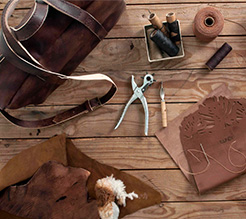How to tell genuine leather from faux leather!
How to tell genuine leather from faux leather? A leather product’s price tag and a “Genuine Leather” label may be able to tell you the answer most of the time, but if you have not been buying a lot of leather goods, you probably can’t tell genuine leather from faux leather!
I couldn’t really tell until I found out these tips that gave me more ideas. on how to tell genuine leather from faux leather!
When I first dabbled with leathers, I thought the word “Genuine Leather” means I’ve just bought the topmost quality leather in the world. In fact, they are not the best grade available in the industry.
In leather manufacturing, the best grade is Full Grain leather, followed by Top Grain leather, and then the Genuine Leather and finally the lowest graded Bonded Leather. (Genuine Leather has been the most popular in the mass market due to several reasons.
If you’re planning to invest on a leather bag from a relatively unknown label who claims to use “genuine” leather despite its really affordable price tag, try these tips to test its authenticity before going to the experts:
Genuine Leather
Genuine leathers are made from the skins of animals, such as cow, goat, sheep, and pig. There are many types of leather, but it can generally be categorised into three types: aniline, semi-aniline, and pigmented. When choosing which type of leather to purchase, consider the desired appearance, and how often the leather will be used.
Aniline Leather
Aniline leather is high quality, top-grain leather that has no protective treatment applied. It is the most natural looking leather. Aniline finishes allow the natural leather markings to show. The leather is susceptible to surface scratches and easily absorbs stains. It is also prone to fading if in the sun for an extended period of time.
Semi-Aniline Leather
Semi-aniline leather is pure aniline leather that has a light surface coating of pigment or clear finish. This increases the durability of the leather and protects it from stains and spills, while still retaining its natural appearance. The surface coating also ensures color consistency throughout the leather.
Pigmented Leather
Pigmented leather is top-grain leather that has been coated with a clear top layer or pigment. Pigments give the leather a shiny, even top color, making the leather have a less natural appearance. Leather is pigmented to provide durability and to hide natural blemishes. It is easy to maintain and has maximum resistance to stains, wear, and fading. Pigmented leather is typically found in furniture and auto upholstery.
Faux Leather
Faux leather is made from a fabric base, which is chemically treated with wax, dye, or polyurethane for a color and texture. Ultimately, it is manmade and exists to give the look and feel of real leather at an exceptionally lower cost. The most common type of faux leather is p leather. It is a plastic fabric made to look like leather. It is lighter and less restrictive than real leather, and can be dyed any color. Faux leather comes in many forms and some are better quality than others. Other types of faux leather include leatherette and vegan leather.
Spotting Faux Leather
The main differences between real and faux leather are the quality and durability. Spotting the difference between faux and real protected leather can be difficult because they can look very similar. There are several techniques that are used to tell genuine leather from faux leather!
Look at the Labels
While it may sound obvious, looking at the label on the product is an easy way to identify the type of leather. Products made of real leather will proudly say so on the label. If the label reads, “manmade materials,” the product is not made of real leather.
Inspect the Edges
Look at the edges of the garment or furniture. Faux leather products will have a perfect-looking edge that feels foamy or plastic. Authentic leather will have a rough-around-the-edges look.
Examine the Pores
When making a leather purchase, closely examine the pores of the fabric. Faux leather will have pores that are in a consistent pattern, while real leather will have inconsistently placed pores.
Touch the Leather
Depending on the quality, real leather can feel coarse or smooth, or anywhere in between. Leather is also flexible and soft. If the item in questions feels really smooth or has a similar feel to plastic, it is likely fake leather. Faux leather also tends to stretch more than real leather. To become familiarised with the feel of real and faux leather, go to a reputable leather store and feel real leather to compare it to faux leather.
Smell the Product
Smell the object for the distinct leather smell. The smell of real leather cannot be replicated by synthetic materials. It may help to go to a department store and smell real leather items and faux leather items to become acquainted with the smell.
Comparing Real and Faux Leather
Real and faux leather have many different qualities. Each type has advantages and disadvantages. Consider several factors when making a leather purchase.
Advantages of Authentic Leather
There is nothing like the smell and feel of real leather. Real leather gives an aura of luxury and prestige. Because no two animal hides are exactly the same, each piece of authentic leather has unique natural characteristics. The leather becomes softer and more attractive over time, which makes it more comfortable. Leather also has a soft, yet strong texture, making it hard-wearing. Many real leather products are also treated to help prevent stains. Leather is easy to take care of when maintained properly; it only needs a regular wiping with a clean, damp cloth.
Disadvantages of Authentic Leather
Real leather is much more expensive than its counterpart. If leather is in constant sunlight, the color may fade. Leather is very porous and absorbent, so drops of liquid will quickly soak into the item if not wiped up promptly. If the leather is not protected, this can result in a stain.
Advantages of Faux Leather
Faux leather has a similar look and feel to genuine leather, while being much more affordable. Some people prefer faux leather simply because no animals are harmed in the making of the material. Faux leather is made from a machine, which ensures that the fabric has an even, consistent color throughout. It can also be dyed into many different colors, and is usually fade resistant.
Disadvantages of Faux Leather
Faux leather has about a third of the life span of real leather. It cracks and splits much easier than real leather, and becomes more uncomfortable over time. It does not develop luster like real leather. Faux leather is very thin and does not offer the warmth of real leather. It also smells like plastic or rubber.
Source: Ebay




